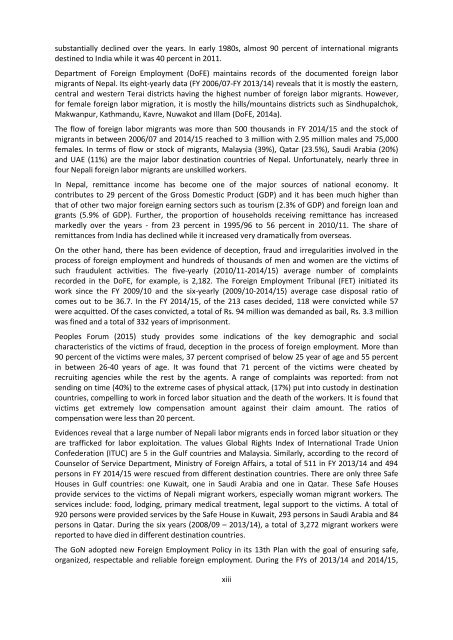TRAFFICKING IN PERSONS
1Spfyta
1Spfyta
You also want an ePaper? Increase the reach of your titles
YUMPU automatically turns print PDFs into web optimized ePapers that Google loves.
have been formed in the country. The number of such groups reached to more than 150,000 in FY<br />
2013/14 from about 124,000 in the FY 2011/12. Examining the proportion of women involvement in<br />
the collectivities by social groups, it appears that the women’s programs are highly representative<br />
and inclusive.<br />
One of the key prevention programs of combating sale of children is the education program. The<br />
GoN has been providing different scholarship schemes at different levels of school education. The<br />
schemes aim to expand equitable access of students at corresponding levels, improve retention rate,<br />
and broaden the meaningful teaching opportunities. Despite this, on the average, 500,000 students<br />
enrolled in grades one to 10 tend to drop-out each year in Nepal.<br />
As a prevention and protection program, Child Helpline with toll free number 1098 has been in<br />
operation 12 districts. In FY 2013/14, six organizations operated child helpline and provided different<br />
services to 4,830 children. In the FY 2014/15, there were 577 Child Care Homes in 44 districts of the<br />
country with 16,400 children residing in these Homes.<br />
A number of I/NGOs are involved in anti-trafficking activities in Nepal. Some of the NGOs have<br />
specific anti-trafficking activities, other work in internal trafficking issues while others have activities<br />
related to safe migration, empowerment of women and children. In addition to the prevention<br />
related activities, NGOs provide protection and legal aid services to the trafficked survivors. A total<br />
of 20 NGOs provided information to NHRC about at least one of the protection or legal aid related<br />
services. Accordingly, about 9,000 persons especially women and children were intercepted from<br />
the border areas, bus parks and other places in each of the fiscal year of 2013/14 and 2014/15.<br />
Similarly, 1551 victims in FY 2013/14 and 1971 in FY 2014/15 were rescued mainly from abroad.<br />
More than 3600 victims especially women and children were referred to different organizations for<br />
psychosocial counseling and medical treatment. It is reported that only four NGOs received 1858<br />
missing person applications in FY 2013/14 and 1906 in FY 2014/15. In terms of legal support which<br />
includes FIR, prosecution and court proceeding, a total of 988 persons in FY 2013/14 and 1355<br />
persons in FY 2014/15 were provided legal support by the 11 NGOs.<br />
NGOs mobilized a lot of resources in the year of 2014. A total of 454.7 million Rupees was mobilized<br />
by 27 NGOs affiliated with Social Welfare Council for 63 projects in the year of 2014. Of the total<br />
funding mobilized, 97 percent came from the external donors while about 3 percent was internal<br />
ones. Among the 27 NGOs listed in SWC, the five-top NGOs that mobilized maximum budget in the<br />
year of 2014 include: CW<strong>IN</strong> (38%), Maiti Nepal (14%), WOREC Nepal (10%), Shakti Samuha (5.5%)<br />
and KI Nepal (5%).<br />
Print media coverage in TIP can be evaluated from a recent study conducted by AATW<strong>IN</strong> (2015). It<br />
covered the news and article published in the five national daily newspapers in between April 14,<br />
2014 to April 13, 2015. The newspapers clippings reviewed when the theme of trafficking, migration<br />
or transportation emerged in the newspapers. Of 1007 news articles published, 61.5 percent of news<br />
was related to migration while only 30 percent was related to trafficking. It appears that media has<br />
not prioritized the issue of trafficking as more than three-forth of the news published in the pages<br />
other than first and editorial. Only 38 percent of the news was covered by only one newspaper and<br />
62 percent of the news was event based hard news. Only in 19 percent of the news, the identity of<br />
trafficked survivors is found to have totally protected.<br />
Key challenges in relation to implementation of policies and programs are to strengthen the<br />
Secretariat of National Committee; increase the coordination among the key line agencies; integrate<br />
TIP prevention activities with the poverty alleviation, education and empowerment programs;<br />
reduce the overlap in program interventions and increase the media coverage on trafficking issues<br />
by ensuring the confidentiality and privacy of the victims/survivors.<br />
xv


